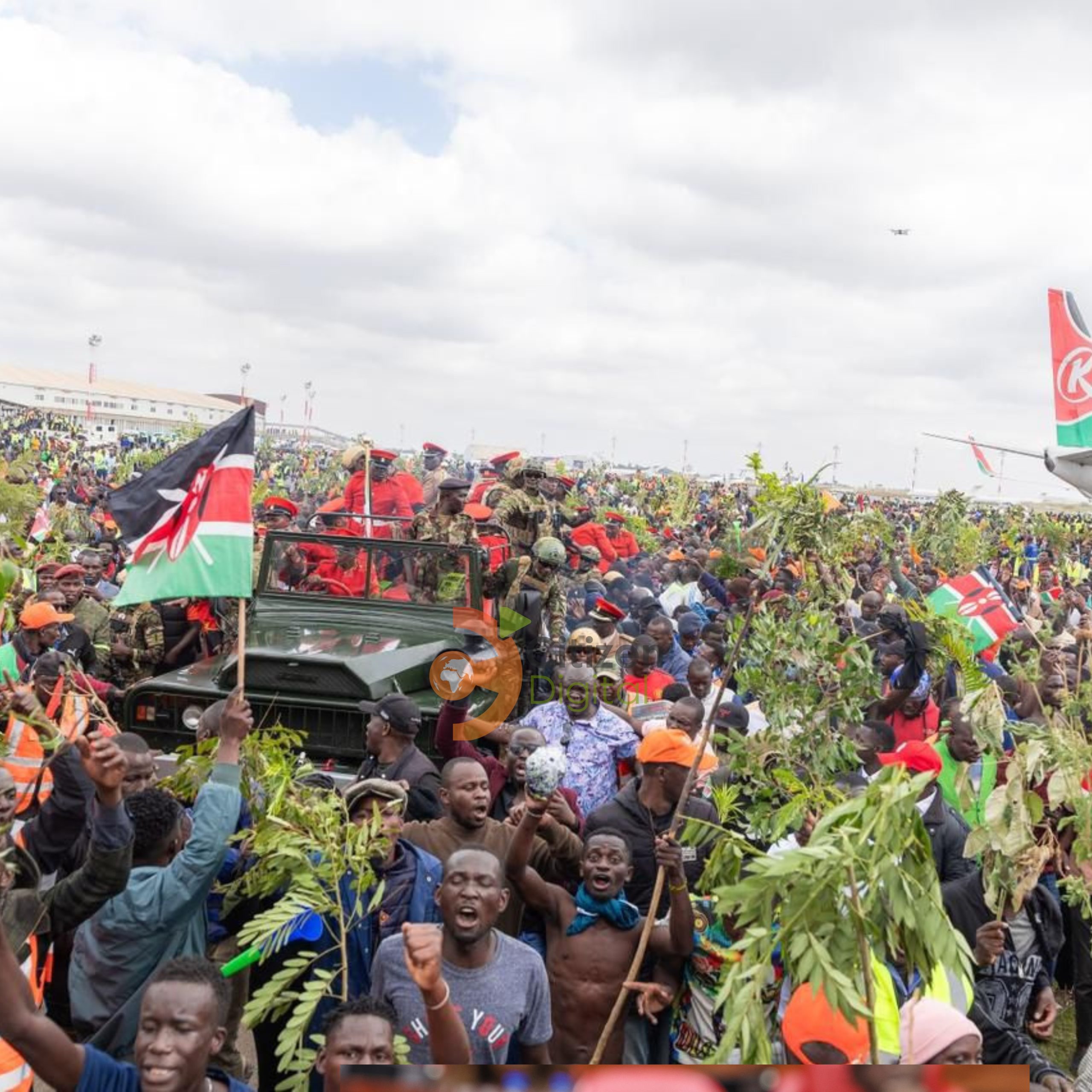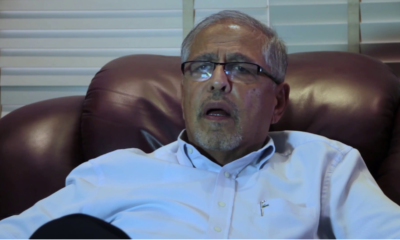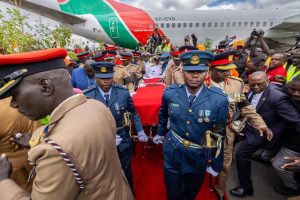News
When Emotion Overwhelmed Protocol: Inside the JKIA Security Breach That Shocked a Nation
This was not a riot or an act of malicious intent. It was grief made manifest, a collective outpouring that defied the neat boundaries security planners had tried to impose.

The aircraft wheels touched down on the JKIA tarmac at precisely 9:33 am on Thursday morning, October 16, 2025.
Kenya Airways flight RAO001, a callsign changed mid-flight from KQ203 in honor of the man whose remains it carried, rolled along the runway as fire trucks sprayed ceremonial jets of water into the morning sky.
It was supposed to be a moment of solemn dignity, a carefully choreographed state reception for former Prime Minister Raila Amolo Odinga, orchestrated down to the last military salute.
Instead, within minutes, it became one of the most spectacular security breaches in the history of Kenya’s main aviation gateway, forcing authorities to shut down the entire airport for two hours and abandon protocols that had taken days to plan.
What unfolded that morning was not merely a failure of security infrastructure but a testament to something far more profound and unpredictable: the raw, uncontainable grief of a nation losing one of its most towering political figures.
The breach exposed the fundamental tension between state ceremony and popular emotion, between military precision and human spontaneity, between what security planners anticipated and what actually transpired when thousands of mourners decided that no barrier, no cordon, no uniformed officer would stand between them and their final glimpse of the man they called Baba.
Security personnel had earlier set up tight security measures around the airport, but the sheer number of mourners overwhelmed the barriers, forcing authorities to abandon the planned military reception protocols.
The arrangements had been meticulous. The casket carrying Raila’s body, draped in the national flag, was to be placed on a wheeled military carrier for a formal state reception, with President William Ruto scheduled to officially receive it, accompanied by former President Uhuru Kenyatta, top government officials, and senior leaders of the ODM party .
But the planners had made a critical miscalculation.
They had prepared for mourners, yes, even anticipated large crowds.
What they had not prepared for was the sheer emotional intensity and determination of thousands who had woken before dawn, some traveling from as far as Kisumu and Mombasa, converging on JKIA with one singular purpose.
These were not passive observers content to watch from designated viewing areas.

Mourners gather to receive the body of former Prime Minister Raila Odinga at the Jomo Kenyatta International Airport on October 16, 2025. Photo credit: PCS
These were supporters who had walked alongside Raila through decades of political struggle, who had been teargassed at his rallies, who had celebrated his victories and mourned his defeats, and who now refused to be kept at arm’s length during this final journey.
The first breach came at the main entrance. Images and videos showed hundreds of civilians, presumably mourners, making their way towards a handful of security personnel, with authorities at the JKIA entrance attempting to negotiate with the crowd, but attempts failing as the crowd forcefully gained access to the airport, chanting phrases like “Baba has arrived”.
It was not a violent surge but rather an unstoppable tide of human emotion.
Security officers found themselves not facing criminals or terrorists, scenarios for which they had trained, but grieving citizens whose determination was fueled by loss and love.
What happened next revealed the full extent of the security collapse.
Crowds of mourners and boda boda riders gained access to the State Pavilion, with efforts by joint security personnel of military and GSU to contain the crowd proving futile as hundreds pushed past the barricades while others scaled the perimeter wall, chanting Raila’s name and waving twigs .
The inclusion of boda boda riders added a particularly Kenyan dimension to the chaos.
These motorcycle taxi operators, many of them young men from Nairobi’s informal settlements who viewed Raila as their champion, did not simply breach on foot. The boda boda riders who gained access to the facility rode into restricted areas, further overwhelming the officers on duty .
The scene was surreal and unprecedented. Within minutes of the aircraft landing, the carefully planned military reception had disintegrated.
Chief of the Defence Forces Charles Muriu Kahariri, who was present at the JKIA, was caught in the crowd and had a brief interaction with civilians before eventually succumbing to the sheer numbers present at the airport .
When even the highest-ranking military officer in the country found himself swept up in the human wave, it became clear that this was not a security situation that could be managed through conventional means.
President William Ruto, who was scheduled to lead the reception of Raila’s body, was unable to do so as the crowds became unruly, with former President Uhuru Kenyatta and other dignitaries also not visible amid the commotion.
The symbolism was striking.
Here were the most powerful figures in Kenya, prepared to honor their political rival with full state ceremony, rendered helpless by the very citizens they governed.
Supporters surrounded Raila’s casket, leaving military personnel on the ground largely unable to control the situation, with efforts by Rarieda MP Otiende Amollo to calm the crowd unsuccessful as mourners continued to mill around the casket .
The consequences were immediate and severe.
The Kenya Airports Authority announced a temporary closure of the airspace over JKIA from 10:26 AM to 12:26 PM as a precautionary measure to ensure maximum safety and order during enhanced security rescreening operations.
This was extraordinary. JKIA, which handles an average of 20,000 passengers daily and serves as Kenya’s primary international gateway, had been effectively shut down.
Flights were delayed, passengers stranded, and the carefully synchronized rhythms of international aviation thrown into disarray.
Acting Managing Director and CEO of KAA Mohamud Gedi stated that the closure was to facilitate an enhanced security rescreening operation, emphasizing that the safety and security of passengers, staff, and all airport users was their highest priority.
The language was diplomatic, but the reality was stark: mourners had penetrated areas of the airport that should have been impregnable.
Restricted zones where only authorized personnel should tread had been flooded with ordinary citizens. The tarmac, runways, and State Pavilion, spaces governed by strict aviation security protocols, had become extensions of the public sphere.
The images that emerged from inside the airport told their own story.
Photos circulated on social media showing mourners not just on the tarmac but exploring various airport facilities.
Photos and videos showed some mourners taking advantage of the facilities available to them, with some even accessing airplanes to take photos.
The scenes were both touching and concerning, capturing the peculiarly Kenyan ability to find moments of levity even in grief, but also raising serious questions about aviation security.
International observers and aviation security experts were quick to note the implications.
Some expressed concern that the breach of security at JKIA could negatively impact the airport’s reputation, with possible international consequences, noting that the airport’s security rating could be downgraded and some countries may refuse direct flights from JKIA.
This was not hyperbole.
Aviation security is governed by strict international standards, and any breach, regardless of its emotional context, triggers mandatory reviews and potential sanctions.
Yet amid the chaos, there was also something profoundly moving.
Despite the disruption, the atmosphere remained largely peaceful, with mourners singing Raila’s popular slogans “Jowie” as the casket was received.
This was not a riot or an act of malicious intent. It was grief made manifest, a collective outpouring that defied the neat boundaries security planners had tried to impose.
The mourners carried twigs and palm branches, symbols of peace in many African traditions, and chanted not threats but the name of the man they had come to honor.
The emotional intensity was captured in individual moments. Mombasa Governor Abdulswamad Shariff Nassir, a long-time ally and loyal supporter of the former Prime Minister, was visibly overwhelmed by emotion, sobbing uncontrollably as his bodyguard watched.
Here was a sitting governor, a man accustomed to public appearances and political theater, reduced to raw grief in the face of loss.
The security breach forced immediate revisions to the entire funeral program.
At Parliament Buildings, officials had to cancel a planned public viewing after they were overwhelmed by the crowd, prompting authorities to relocate the public viewing from Parliament to Kasarani Stadium . The cascading effects continued.
At Lee Funeral Home, security was also heightened after reports of a security breach, with officials canceling plans to hold the body there briefly and deciding to move it directly to Kasarani .
What the JKIA breach revealed was a fundamental disconnect between official expectations and popular sentiment.
Security planners had prepared for a state funeral, complete with military honors and diplomatic protocol.
What they got was something closer to a popular uprising, not of anger but of affection, not of violence but of an overwhelming desire to be present, to witness, to participate in this final farewell.
The route of the funeral procession itself had to be changed on the fly.
Homa Bay Governor Gladys Wanga told mourners at JKIA that the procession would use Mombasa Road instead of the Nairobi Expressway to allow Kenyans to pay their last respects, with hundreds of mourners escorting the body being carried on a gun carrier with the casket draped in a national flag.
This was pragmatism born of necessity.
If the crowds could not be contained at the airport, better to channel them along a route that acknowledged their presence rather than attempting the impossible task of keeping them away.
The incident also exposed darker undercurrents. Security was enhanced at both the Nairobi and Bondo homes of Raila Odinga after several mourners complained of being harassed and robbed by goons hiding among supporters, with police mounting roadblocks at the entrance to Odinga’s home.
In the chaos and emotion, opportunists had found cover, a reminder that even genuine grief can provide camouflage for those with less noble intentions.
By early afternoon, order had been restored. The Kenya Airports Authority confirmed that normal activities were back to normal, with the authority advising passengers with flights scheduled during the closure to contact their respective airlines for updated flight information.
The immediate crisis had passed, but the questions it raised lingered.
How had thousands of mourners so easily overwhelmed what should have been one of the most secure facilities in the country? Was this a failure of intelligence, of manpower, of planning, or of all three?
The answer, perhaps, is that it was none of these and all of these.
Security protocols are designed around rational actors making predictable choices. They account for terrorists seeking to cause harm, smugglers seeking to evade detection, unauthorized persons seeking illicit access.
They are not designed to handle thousands of people acting simultaneously on pure emotion, driven not by malice but by love and grief and the overwhelming human need to bear witness to significant moments.
In the days that followed, there would be official reviews, security assessments, and likely some quiet disciplinary actions.
But what cannot be measured in incident reports or security audits is the human dimension of what occurred at JKIA that Thursday morning.
In breaching those barriers, those mourners were making a statement, perhaps unconsciously, about ownership and participation in national moments.
They were asserting that Raila Odinga belonged not just to the state with its ceremonies and protocols, but to the people who had walked with him through decades of political struggle.
The former Prime Minister, who built his political career on challenging established order and championing the common person against entrenched power, might have appreciated the irony.
In death, as in life, his supporters refused to be managed, contained, or kept at a distance.
They breached barriers, overwhelmed security, and inserted themselves into the narrative, transforming a state occasion into a popular moment.
Whether this represents a failure of security planning or a success of popular participation depends on one’s perspective.
What is undeniable is that for two hours on that October morning, the carefully maintained boundaries between official and popular Kenya collapsed.
The result was chaos, yes, but also something authentically Kenyan in its spontaneity, its emotion, and its refusal to be contained by official protocols.
The mourners at JKIA did not just breach security. They breached the careful distance that modern states try to maintain between power and people, between official ceremony and popular feeling. In doing so, they provided one final tribute to a man who spent his life challenging exactly those kinds of boundaries.
Kenya Insights allows guest blogging, if you want to be published on Kenya’s most authoritative and accurate blog, have an expose, news TIPS, story angles, human interest stories, drop us an email on [email protected] or via Telegram
-

 News5 days ago
News5 days agoTemporary Reprieve As Mohamed Jaffer Wins Mombasa Land Compensation Despite Losing LPG Monopoly and Bitter Fallout With Johos
-

 Business2 weeks ago
Business2 weeks agoPanic As Payless Africa Freezes With Billions of Customers Cash After Costly Jambopay Blunder
-

 Investigations5 days ago
Investigations5 days agoFrom Daily Bribes to Billions Frozen: The Jambopay Empire Crumbles as CEO Danson Muchemi’s Scandal-Plagued Past Catches Up
-

 Sports4 days ago
Sports4 days ago1Win Games 2025: Ultimate Overview of Popular Casino, Sports & Live Games
-

 Business5 days ago
Business5 days agoHass Petroleum Empire Faces Collapse as Court Greenlights KSh 1.2 Billion Property Auction
-

 Investigations1 week ago
Investigations1 week agoHow SportPesa Outfoxed Paul Ndung’u Of His Stakes With A Wrong Address Letter
-

 News5 days ago
News5 days agoShanta Gold’s Sh680 Billion Gold Discovery in Kakamega Becomes A Nightmare For Community With Deaths, Investors Scare
-

 Investigations1 week ago
Investigations1 week agoInside the Deadly CBD Chase That Left Two Suspects Down After Targeting Equity Bank Customer Amid Insider Leak Fears






















